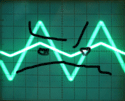|
It depends on the processor architecture what a bitwise shift actually does. So maybe that? Idk.
|
|
|
|

|
| # ? Jun 5, 2024 21:16 |
|
What's the best way to capture and demodulate a 433.92 bfsk transmission
|
|
|
|
Gnuradio It's free software
|
|
|
|
spankmeister posted:Gnuradio Im on windows and it doesn't want to recognize my rtl sdr
|
|
|
|
Sagebrush posted:got what i imagine is a real simple question: on ARM you can even do this in one instruction: uxtb r0, r1, ror #24
|
|
|
|
Sagebrush posted:got what i imagine is a real simple question: if it compiles to a logical shift instruction then both are the same since logical shifting right puts zeros in at the left-hand side, so there's no need to zero them out later. whereas if it compiles to an arithmetic shift instruction then the left bits will be copies of the MSB of the input value (this preserves the sign in the result), so the leftmost bits might not be zero. it depends on the architecture/compiler, and whether or not the input value is declared as signed or unsigned. if you want it to be portable then shift+mask is more likely to be correct across different systems, but shifting alone is probably correct in 95% of cases.
|
|
|
|
Malcolm XML posted:Im on windows and it doesn't want to recognize my rtl sdr run linux in a vm and hook up the usb to the vm srsly it works a lot better that way
|
|
|
|
Sweevo posted:if it compiles to a logical shift instruction then both are the same since logical shifting right puts zeros in at the left-hand side, so there's no need to zero them out later. whereas if it compiles to an arithmetic shift instruction then the left bits will be copies of the MSB of the input value (this preserves the sign in the result), so the leftmost bits might not be zero. it depends on the architecture/compiler, and whether or not the input value is declared as signed or unsigned. if you want it to be portable then shift+mask is more likely to be correct across different systems, but shifting alone is probably correct in 95% of cases. Thank you this is what I was getting at but couldn't explain.
|
|
|
|
don't use signed types for bit twiddling or you will suffer greatly tbh logical shift and arithmetic shift should have been separate operators. 99% of the time you don't want the behaviour to differ based on signedness
|
|
|
|
what use case does logical shift have except trying to out-optimise the compiler when multiplying/dividing by powers of 2?
|
|
|
|
a thread about janitoring individual bits - what use case does logical shift have
|
|
|
|
Spatial posted:a thread about janitoring individual bits - what use case does logical shift have what use case does it have in a high level programming language if you're writing asm and dealing with signed numbers maybe? I'm not sure I've ever written anything where it'd be relevant
|
|
|
|
Wait poo poo I got them the wrong way around. I'm all for bitshifting, I guess I meant arithmetic shift
|
|
|
|
gonadic io posted:what use case does logical shift have except trying to out-optimise the compiler when multiplying/dividing by powers of 2? they both have their uses. the difference is down to what happens to the MSB during right shifts.  if you're using it for division then arithmetic shift gives the wrong result for unsigned values that have the MSB set, whereas logical shift gives the wrong result for negative values. which one to use depends on whether the input is signed or not, and whether you're using the shift to divide by 2, or to actually move the bits around for some low-level reason like dealing with hardware registers. the divide by 2 thing was a big deal before processors had divide instructions, or where the divide instruction was very slow. for left shifts both logical and arithmetic shifts do the same thing and just shift the bits one place left. this works correctly regardless of the sign of the input, so logical and arithmetic left shifts are compiled to the same instruction. Sweevo fucked around with this message at 16:24 on Jul 21, 2017 |
|
|
|
oh. well arithmetic shifts aren't that common. i've only used them for two reasons: fixed point arithmetic scaling while preserving signedness and for dynamically generating bitfield masks. this is part of why i suggested splitting arithmetic/logic shifts into separate operators, because sign extension is usually not what you want.
|
|
|
|
they're the same in C for historical reasons. iirc the C standard says the results of all shifts are implementation dependant, since many early architectures only had one or the other, or had neither but could fudge it using rotate instructions or whatever.
|
|
|
|
arithmetic shifts are useless imvho
|
|
|
|
in a microarch i worked on a while back i added the ability to do extending shifts in both directions. i.e. there's msb extending right shift and lsb extending left shift.  one is useful for fixed point, the other is for generating masks quickly (also used in other instructions not just shifts)
|
|
|
|
whats the best way to prevent interference to an EMG circuit? do i have to wrap my arm in a faraday cage?
|
|
|
|
Spatial posted:oh. well arithmetic shifts aren't that common. i've only used them for two reasons: fixed point arithmetic scaling while preserving signedness and for dynamically generating bitfield masks. this is part of why i suggested splitting arithmetic/logic shifts into separate operators, because sign extension is usually not what you want. arithmetic shift is more common than you think below the level of an explicit language feature; compilers transform 'divide by a constant which is a power of 2' into shifts all the time before anyone asks, yes they still do this even with hardware divide support. idk where it's at now, but last i paid any attention to it, a hardware divider with performance of 4 bits of output produced per clock cycle was considered good. a shift is usually much faster, and fully pipelined.
|
|
|
|
Apocadall posted:whats the best way to prevent interference to an EMG circuit? do i have to wrap my arm in a faraday cage? twist your pairs common mode rejection notch filter peep this thing called right leg drive better electrode contact (or just better electrodes)
|
|
|
|
Bloody posted:what kinda interference? what's it's spectrum look like? broadly: mains interference around 60hz, EMG signals are between 50hz and 3khz. voltages are between 1nV to 300nV and have to be amplified a lot to get a usable signal but last test i did i had so much noise that i couldn't get any sort of signal to show up on the scope. i got maybe one good spike in the hour i was hooked up to it. a notch filter wont work because i need access to that band still, but i want to eliminate interference into that frequency i'm trying to read https://en.wikipedia.org/wiki/Driven_right_leg_circuit oh man i had no idea about this thing, thanks for the recommendation electrodes i have no idea what to do about those, it was a pain in the rear end just getting what i do have, which are single use tabs that i run alligator clips to and then clip to the board, crappy but worked once (out of god knows how many tries). any ideas for better electrodes? i'd test on something with higher voltage first like the heart beat but it's at a different frequency than what i'm aiming for
|
|
|
|
it does look like there is a lot more available for electrodes now than there was when i got my last bag
|
|
|
|
Apocadall posted:mains interference around 60hz, EMG signals are between 50hz and 3khz. voltages are between 1nV to 300nV and have to be amplified a lot to get a usable signal but last test i did i had so much noise that i couldn't get any sort of signal to show up on the scope. i got maybe one good spike in the hour i was hooked up to it. uhhh if your signals are 1nV-300nV either you're not looking at EMG or your electrodes are hilariously bad ime
|
|
|
|
you should be able to get muscle flexion pretty easily with any surface electrode pair, like if you stick one at the base of your thumb at the wrist and then up towards the top of that bigass thumb muscle you should expect to see lotsa bigass EMG signals in the 1s to 10s of mV range. i dont remember the frequency ranges off the top of my head but 50-3k sounds kinda high. i know you get tons of muscle artifacts in EEG, which is more like 1-50 Hz what are you using for an amp?
|
|
|
|
Sweevo posted:if it compiles to a logical shift instruction then both are the same since logical shifting right puts zeros in at the left-hand side, so there's no need to zero them out later. whereas if it compiles to an arithmetic shift instruction then the left bits will be copies of the MSB of the input value (this preserves the sign in the result), so the leftmost bits might not be zero. it depends on the architecture/compiler, and whether or not the input value is declared as signed or unsigned. if you want it to be portable then shift+mask is more likely to be correct across different systems, but shifting alone is probably correct in 95% of cases. well, it's running on a cortex-m4 and i'm operating only on uint32_ts. using the mask to ensure safety for signed types makes sense. is it one cycle slower to do that, though? good to know that for this case it should work either way, though. that's what it seemed like but wanted to be sure. on a related note, is this the right practice? code:similarly, if i passed a pointer to boobs, would that also recover the MSB because it just reads the first 8 bits from that location?
|
|
|
|
BobHoward posted:arithmetic shift is more common than you think below the level of an explicit language feature; compilers transform 'divide by a constant which is a power of 2' into shifts all the time  i was only talking about explicit usage of the operator. i was only talking about explicit usage of the operator.4 bits per clock is still the norm. funnily enough the tiny arm cortex mcus have better division performance than x86 on a cycle for cycle basis: the cortex m3 does 32/32 bits in at most 12 cycles, while ivy bridge takes 25 cycles. of course in reality there's no competition because of the gulf in clock frequency. arm can afford to make the critical path much longer. but still i found this surprising when i worked with them at first. a cool trick modern implementations do is reusing the bitscan/clz hardware to shortcut the division depending on the number of high bits set. because of this an m3 can pull off a division in just a few cycles if the operands are small. however it still can't compete with a shift, which will likely be combined with another operation for free thanks to the whole flexible operand2 thing in the isa.
|
|
|
|
Sagebrush posted:
at a low level this code would compile to something like: - load boobs - shift boobs right by 24 bits - zero extend boobs to 8 bits - call foo - return quote:similarly, if i passed a pointer to boobs, would that also recover the MSB because it just reads the first 8 bits from that location? code:
|
|
|
|
Spatial posted:it won't do what you expect because of endianness. the m4 is little endian which means the byte order is reversed in memory compared to the layout of a register. accessing the first byte in memory will read the least significant byte of the value! the cortex m4 itself is bi-endian, but I think most (all?) of them on the market are little endian only
|
|
|
|
yeah, true
|
|
|
|
Sagebrush posted:well, it's running on a cortex-m4 and i'm operating only on uint32_ts. using the mask to ensure safety for signed types makes sense. is it one cycle slower to do that, though? I'm gonna blow your mind with this poo poo: https://godbolt.org/
|
|
|
|
Poopernickel posted:I'm gonna blow your mind with this poo poo: yeah, just reduce to a snippet and see what actually happens for your target compiler/platform like i honestly dont know what this means Spatial posted:- zero extend boobs to 8 bits registers (on a m4f?) are 32, the upper ones of which will be 0 after shifting and not need an explicit instruction, there are strb and strw instructions for store byte and store word if its going out to memory so even if the upper bits were polluted it wouldn't matter too much
|
|
|
|
i wasn't talking about what the optimiser can theoretically produce. the question was about what the language actually means. when you assign a uint32 to a uint8 it means do a narrowing conversion, and UXTB (zero extend to 8 bits) is the most literal translation of that on ARMv7-M.
|
|
|
|
Spatial posted:the question was about what the language actually means. when you assign a uint32 to a uint8 it means do a narrowing conversion, and UXTB (zero extend to 8 bits) is the most literal translation of that on ARMv7-M. there's no zero extending to get the right shift of 32 by 24 to fill out 8 but ok sure
|
|
|
|
duh. i'm giving the most general explanation. don't be a nit picker
|
|
|
|
well i am already significantly more confused but anyway, update on the vaporwave motorcycle instrument cluster: alpha version works! https://www.youtube.com/watch?v=GoSAprKVoQg got the whole thing finally assembled and installed and running with the v.0.1 code. still lots of UX things to work on, some industrial design changes I want to make, and lots of little details of calibration (temperature gauges, gamma table to balance the lighting, etc) but the basics do work! i am particularly happy with that analog filter/comparator i built earlier using the advice in this thread. reminder: it takes the incredibly noisy ~350v signal from the spark plug coil and shapes it down to a clean 3.3v square wave with hysteresis so i can have a tachometer. i installed the thing, spent 30 seconds adjusting the trimpot to set the correct threshold, and bam -- beautiful and accurate and i took the bike on a 100 mile test ride and i don't think i saw a single tachometer glitch the entire time. it's so smooth and responsive that i don't even need to filter the data, though i am going to do a really small median filter or something to cut down on the flickering when it's right between two LEDs on the scale.   
|
|
|
|
Sagebrush posted:it's so smooth and responsive that i don't even need to filter the data, though i am going to do a really small median filter or something to cut down on the flickering when it's right between two LEDs on the scale. are you planning to do some filtering or rounding-off of the numeric RPM value? the current output seems visually distracting as the 10's and 1's digits bounce around, so maybe rounding it off to the nearest 50 or 100 RPM for display? the project looks great though.
|
|
|
|
amber lcd looks great is the wireframe grid movement speed going to vary with actual wheel speed? or at least stop when the bike is stopped? also maybe consider not using red for the bottom of the RPM scale, keep that for near/at redline? usually to me red on an instrument cluster is an "oh poo poo" color.
|
|
|
|
pretty drat cool 
|
|
|
|

|
| # ? Jun 5, 2024 21:16 |
|
Yeah definitely going to round the rpm to the nearest something-or-other. It's fairly distracting as is, not to mention impossible to read. Minor details, though -- that's like 10 lines of code obv. Right now the tachometer cycles through red/amber/green/amber/red as it goes through the power band, but I'm thinking of making it just monochrome with red at the redline, yeah. Infinite options for color-coding stuff like that. Personally I would have liked for the whole system to be red, but these OLEDs are only available in green and amber 
|
|
|






















